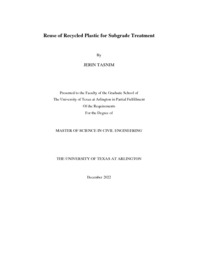
ATTENTION: The works hosted here are being migrated to a new repository that will consolidate resources, improve discoverability, and better show UTA's research impact on the global community. We will update authors as the migration progresses. Please see MavMatrix for more information.
Show simple item record
| dc.contributor.advisor | Hossain, MD Sahadat | |
| dc.creator | Tasnim, Jerin | |
| dc.date.accessioned | 2023-01-26T16:15:21Z | |
| dc.date.available | 2023-01-26T16:15:21Z | |
| dc.date.created | 2022-12 | |
| dc.date.issued | 2022-12-19 | |
| dc.date.submitted | December 2022 | |
| dc.identifier.uri | http://hdl.handle.net/10106/31040 | |
| dc.description.abstract | Disposal of solid waste becomes a global issue due to it contains a large amount of non- degradable polymers and may lead to many environmental issues. With the scarcity of space for landfilling and due to ever increasing cost, finding ways to handle these wastes without endangering the environment is crucial. One of these methods is to use plastic wastes as one of the pavement materials. In this study, a new method of subgrade soil stabilization of pavement is proposed where soil will be stabilized by mixing only plastic with soil for the treatment of subgrade.
In order to demonstrate and quantify the benefit of plastic in improving subgrade soil, HDPE, PET and PP have been shredded and mixed with soil. Standard laboratory tests were conducted to assess the stabilization's impact. These tests were carried out on four plastic contents of 2%, 3%, 4%, and 5% of the soil weight in natural and stabilized soils. The tests were the standard compaction test, unconfined compressive strength (UCS) test, hydraulic conductivity test and swelling tests.
According to laboratory test results, the presence of plastics reduces the stabilized soils' maximum dry density (MDD) and optimal moisture content (OMC), both of which are necessary for the construction of lightweight embankments. Additionally, the UCS of soils significantly improved by up to 88%, 75%, and 57% for HDPE, PET, and PP, respectively. The findings of the laboratory tests also showed that plastic treatment enhanced the soil's hydraulic conductivity, and that the degree of this increase was more significant at larger dosages. PET showed the best result regarding increasing the hydraulic conductivity of plastic treated soil. By mixing plastics with soil, the hydraulic conductivity was increased by 100 times approximately. Similarly, when the soil is mixed with plastic, the swelling behavior of soil is reduced significantly. Soil showed 73%, 71% and 67% improvement regarding swelling when the soil was treated with 5% of HDPE, PET and PP, respectively. | |
| dc.format.mimetype | application/pdf | |
| dc.language.iso | en_US | |
| dc.subject | Subgrade | |
| dc.subject | Plastic waste | |
| dc.subject | Stabilization | |
| dc.subject | Clay soil | |
| dc.subject | Unconfined compressive strength | |
| dc.subject | Optimum moisture content | |
| dc.subject | Swelling | |
| dc.subject | Permeability | |
| dc.title | Reuse of Recycled Plastic for Subgrade Treatment | |
| dc.type | Thesis | |
| dc.date.updated | 2023-01-26T16:15:21Z | |
| thesis.degree.department | Civil Engineering | |
| thesis.degree.grantor | The University of Texas at Arlington | |
| thesis.degree.level | Masters | |
| thesis.degree.name | Master of Science in Civil Engineering | |
| dc.type.material | text | |
Files in this item
- Name:
- TASNIM-THESIS-2022.pdf
- Size:
- 3.290Mb
- Format:
- PDF
This item appears in the following Collection(s)
Show simple item record


